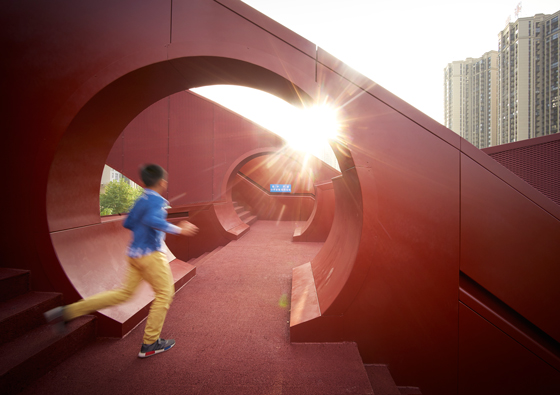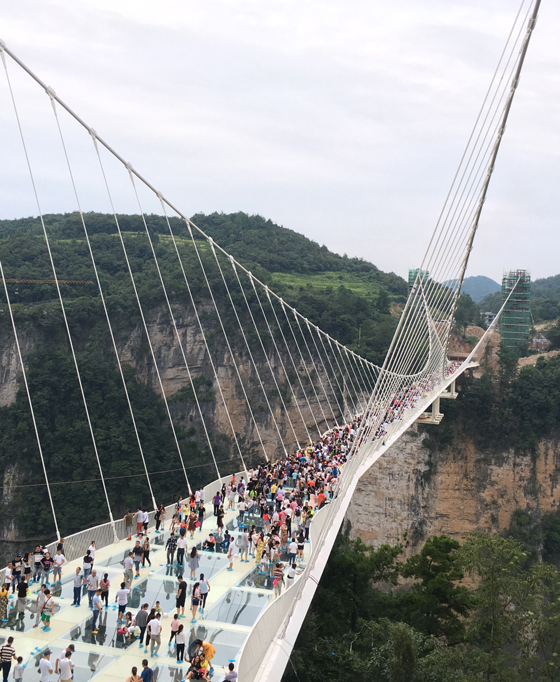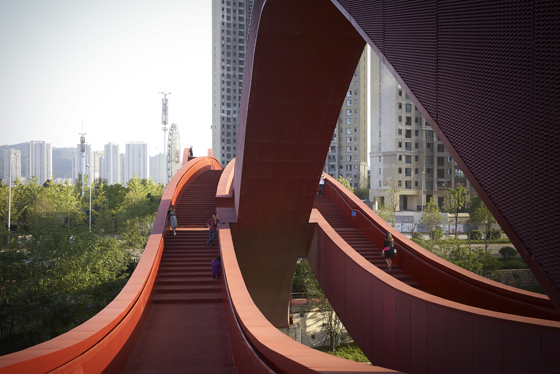On your side: new bridge projects
Texte par Alyn Griffiths
London, Royaume-Uni
21.11.17
Architects around the world are delivering bridges that exceed the limits of their utilitarian function – acting not only structures for crossing but also spaces to congregate and survey.
The WAF-nominated Lucky Knot bridge rises and falls while traversing the Dragon King Harbour River in the Chinese megacity of Changsha. Photo: Julien Lanoo

The WAF-nominated Lucky Knot bridge rises and falls while traversing the Dragon King Harbour River in the Chinese megacity of Changsha. Photo: Julien Lanoo
×Most bridges are purely functional structures, built to provide a fast and direct route from one point to another. Sometimes, however, the location and elevation of a bridge makes it worth slowing down a bit to enjoy the view. Architects today are creating crossings in both urban and rural contexts that apply innovative forms and engineering to enhance this benefit of bridges.
In Switzerland, the world’s longest pedestrian suspension bridge provides jaw-dropping vistas of the Matterhorn as it traverses a deep valley between the towns of Grächen and Zermatt. The 494-metre-long Charles Kuonen Suspension Bridge cuts around three hours off the time required to hike between the two towns, but its popularity is all to do with the exhilarating experience of gazing down at the valley below through the grated-metal floor.
The Charles Kuonen Suspension Bridge provides walkers a shortcut on the popular two-day hiking route between Grächen and Zermatt and offers views of the Matterhorn and Bernese Alps as well as the valley’s base 85 metres below. Photos: Valentin-Flauraud

The Charles Kuonen Suspension Bridge provides walkers a shortcut on the popular two-day hiking route between Grächen and Zermatt and offers views of the Matterhorn and Bernese Alps as well as the valley’s base 85 metres below. Photos: Valentin-Flauraud
×Anyone afraid of heights might want to avoid a couple of recently completed bridges designed to optimise vertiginous views of their surroundings. Zhangjiajie Grand Canyon Glass Bridge in China’s Hunan Province is a 385-metre-long suspension bridge spanning a gorge that drops down 300 metres. Described by architect Haim Dotan as “a dream in nature”, the bridge provides panoramic views of the surrounding landscape, as well as the possibility to look straight down through its glass floor.
Unlike most bridges, Zhangjiajie Grand Canyon Glass Bridge is an attraction in its own right and can accommodate up to 800 visitors at once

Unlike most bridges, Zhangjiajie Grand Canyon Glass Bridge is an attraction in its own right and can accommodate up to 800 visitors at once
×In urban contexts, bridges can also offer some of the best vantage points. The Citadella Bridge in the Italian city of Alessandria by Richard Meier & Partners provides two separate routes for pedestrians and vehicles, allowing users to take in views of the Tanaro River. The wide walkway also creates a new public space between the urban centre and an 18th-century citadel on the opposite bank.
The Citadella Bridge replaces a crossing that was traffic-congested and difficult for pedestrians to use. Its paved walkway references the materiality of Alessandria’s streetscapes and provides a viewpoint across the city. Photos: Hufton+Crow

The Citadella Bridge replaces a crossing that was traffic-congested and difficult for pedestrians to use. Its paved walkway references the materiality of Alessandria’s streetscapes and provides a viewpoint across the city. Photos: Hufton+Crow
×The Lucky Knot bridge in the Chinese city of Changsha was designed by NEXT Architects as “a unique gesture to inspire passersby”. Its twisting form references the endless Möbius strip, as well as the lucky Chinese symbol of a knot. Multiple walkways rise and fall as they traverse the Dragon King Harbour River, providing panoramic views from several peaks. Ascending to the vantage points is not the fastest way across, but this bridge is definitely more about the journey than the destination.
Circular openings punched into the side walls of the Lucky Knot bridge enable users to switch between the various routes. The curving structure touches the ground at several points to allow people to enter and exit wherever they like. Photos: Julien Lanoo

Circular openings punched into the side walls of the Lucky Knot bridge enable users to switch between the various routes. The curving structure touches the ground at several points to allow people to enter and exit wherever they like. Photos: Julien Lanoo
ש Architonic




















